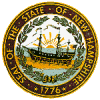



State Seal, New Hampshire Almanac
The New Hampshire state seal has an interesting history, read about it below.

State Seal
The seal of the state shall be 2 inches in diameter, circular, with the following detail and no other: A field crossed by a straight horizon line of the sea, above the center of the field; concentric with the field the rising sun, exposed above the horizon about 1/3 of its diameter; the field encompassed with laurel; across the field for the full width within the laurel a broadside view of the frigate Raleigh, on the stocks; the ship’s bow dexter and higher than the stern; the 3 lower masts shown in place, together with the fore, main and mizzen tops, shrouds and mainstays; an ensign staff at the stern flies the United States flag authorized by act of Congress June 14, 1777; a jury staff on the mainmast and another on the foremast each flies a penant; flags and pennants are streaming to the dexter side; the hull is shown without a rudder; below the ship the field is divided into land and water by a double diagonal line whose highest point is sinister; no detail is shown anywhere on the water, nor any on the land between the water and the stocks except a granite boulder on the dexter side; encircling the field is the inscription, SEAL OF THE STATE OF NEW HAMPSHIRE, the words separated by round periods, except between the parts of New Hampshire; at the lowest point of the inscription is the date 1776, flanked on either side by a 5-pointed star, which group separates the beginning and end of the inscription; the whole form and design to be as follows:

New Hampshire has had a state seal for more than 200 years, but its present form is only 50 years old.
The seal was first created in 1775 by the First Provincial Congress. It comprised a pine tree and an upright fish, on each side of a bundle of five arrows. The design reflected the state’s then two major economic resources, and the arrows symbolized the strength of unity among the then five counties.
When the present state constitution became effective in 1784, the new Legislature revised the seal, to depict a ship on stocks, with a rising sun in the background, to reflect Portsmouth having become a major shipbuilding center during the war years. Various items for shipment were also shown on a frontal dock.
Details of this 1784 seal became so distorted in the ensuing century and a half that the 1931 Legislature voted major improvements, and, or the first time, spelled out its makeup. Director Otis G. Hammond of the New Hampshire Historical Society sparked this adjustment, by reporting that artists and sketchers had injected surprising details into the seal, as they produced new dies every few years for official state use. They produced rum barrels on the dock, and, on occasion, even human beings beside them.
When Governor John G. Winant of Concord launched a second term in 1931, he named a committee to serve with Hammond, to produce a less objectionable seal. The 1931 Legislature readily approved its recommendations.
Historic Warship Honored. The frigate Raleigh, built at Portsmouth in 1776, as one of the first 13 warships sponsored by the Continental Congress for a new American navy, became the centerpiece of the 1931 seal. The figure 1784 on the old seal was changed to 1776. The old Latin phrase "Neo Hantoniensis 1784 Sigillum Republica" around the circular seal was replaced with "Seal of the state of New Hampshire 1776." The 1931 seal law spelled out that only a granite boulder could be shown in the foreground, as symbolic of the Granite State’s rugged terrain and the character of its citizenry.
The Raleigh has a checkered career of adversities, while becoming the first to carry the American flag into sea battle. She was unable to go to sea for 15 months for lack of armament, and after her first voyage to France for munitions, her captain was dismissed for incompetency. Soon thereafter she was beached off Maine, captured by British warships, and used for the remainder of the Revolutionary War against her own country.
Captain John F. Rowe (USN retired) of Newington resurrected the life and lore of the Raleigh in recent years. The British liked the sturdiness of the frigate so much that they sketched its construction details, to build others like it, and Captain Rowe obtained the drawings from London, to enable him to paint the Raleigh in all its pristine glory. And when Governor Hugh J. Gallen and his Executive Council celebrated the 300th anniversary of New Hampshire’s state government, Publisher William Loeb of the Union Leader and New Hampshire Sunday News purchased an enlarged portrait of the Raleigh, by Captain Rowe, and presented it to the state for permanent display in the State House.
Source: New Hampshire Revised Statutes Annotated (RSA) 3:9; Anderson, Leon. History. Manual for the General Court 1981.
The New Hampshire Almanac is compiled by the New Hampshire State Library from state statutes and other sources as noted.
NH.gov - The Official Web Portal of the State of New Hampshire